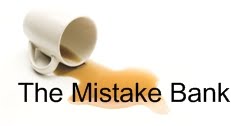There are a number of reasons I've written less on the blog this year. One is that, after more than 5 years of thinking about mistakes and writing
the book, I was running out of interesting things to say and observe (it's not an accident that most of the posts this year are stories and not items discussing mistakes and failure).
But another important reason is what has been called the "
fetishization of failure." It has just become too trendy and easy to write about how we should all learn from failure, "fail fast and often," etc. etc. Too easy to start conferences on the topic, Twitter feeds, etc.
I believe that most or all of the people who have jumped on the failure bandwagon recently are well-intentioned and wish to raise people's awareness of the values of failure. But the inevitable result has been a watering-down and trivialization of something I consider really important.
And then. And then, scholars with serious credentials in this area like Francesca Gino, Bradley Staats and Christopher Myers publish a paper entitled, "
'My Bad!' How Internal Attribution and Ambiguity of Responsibility Affect Learning from Failure" - a deeply-researched, well-written, clearly presented argument on how individuals' ability to learn from failure is directly affected by how they view their responsibility for it.
This isn't a new idea (
the book has a section on "owning your mistakes") but rarely have I seen as impressive a discussion of the topic - and new research to boot. Gino et. al. start off with as clear a summary as you can get of previous scholarship on learning from failure. For example:
Learning from failed experiences has been of particular interest as organizations seek to adapt and avoid repeating prior failures (Ingram & Baum, 1997, Kim & Miner, 2007, Madsen & Desai, 2010). Relative to successful experiences, failures have been seen as more effective triggers of individuals’ learning efforts, because they reveal a gap in ability that stimulates efforts to “tweak” existing practices, search for new capabilities, and develop innovative solutions (Sitkin, 1992, March & Simon, 1993, Baum & Dahlin, 2007, Hora & Klassen, 2013). Following traditional theories of individual learning (e.g., Kolb, 1984), failure can be seen as a form of unexpected event (i.e., where actual outcomes differ from expected outcomes; Allwood, 1984) that creates a sense of discomfort that triggers individuals to make sense of it, test hypotheses, and stimulate growth (Louis & Sutton, 1991, Ellis, Mendel, & Nir, 2006). At the same time, by revealing that an existing strategy is unsuccessful, failures encourage broader search for new strategies (i.e., exploration), resulting in enhanced long-term innovation (March, 1991, Audia & Goncalo, 2007). Indeed, after a successful experience, it is more difficult to detect deviations from a plan (Ellis, Mendel, & Nir, 2006), as the successful outcome confirms the validity of a prior routine (Weick, 1984, Sitkin, 1992) and builds confidence (and complacency) regarding its utility for future performance (Weick, Sutcliffe, & Obstfeld, 1999).
Note, first of all, the wealth of citations in the preceding paragraph. Learning from failure, or "unexpected events," which is closer to the definition I use in the book, is not a fad. It is a well-researched, grounded, fact. It is also easy to avoid - "ambiguity of responsibility" gives credence to individuals who wish to distance themselves from failure.
The new research presented is also profound. The authors test four hypotheses, two of which are central to everyone's ideas of learning from failure:
Hypothesis 2: The learning effects of failure are driven by internal attribution of the failed experience. Specifically, internal attribution moderates the effect of failure on learning, such that the effect of failure on learning is more positive when the failure is attributed more internally.
Hypothesis 3: Ambiguity of responsibility decreases internal attribution and learning from failure
The experiments carried out validated both these hypotheses - test subjects who took responsibility for a failure learned more, and situations where responsibility was unclear did not provide as strong a basis for learning from the failure. This is important stuff (and, as the authors suggest, an area where more study is needed).
Go ahead and follow the failure Twitter feeds and attend the conferences if you want, but, if you really want to understand how people learn from mistakes and how to improve the environment for such learning, read "My Bad!"




